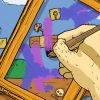…Or take Super Mario Clouds, where Cory modified an NES cartridge and removed all the graphics except the clouds.
To me, as an art historian, that’s a disruptive gesture to the gameness of the game. But it’s not trying to use the unique qualities of games to create an experience the same way that Eric [Zimmerman] or Tracy [Fullerton] might. I don’t think that should mean that these folks should stop what they are doing. That’s the punk rocker in me, that loves the way they’re tweaking games; but from the point of view of someone who wants to advance the cause of games, I see them as something different. They’re not trying to work with games in a constructive way.
From an art historian’s perspective, are there any promising antecedents of work that does embrace games?
One of my favorite examples was this project called Open Score. This was part of the 9 Evenings projects in the ‘60s. Robert Rauschenberg was a well-known painter and Billy Klüver was an employee of Bell Labs. They had two people—a tennis player and then the painter Frank Stella—play a game at night. The racket had sensors and would play a musical note and slightly dim the light. As they played, they were essentially writing a piece of music but also slowly impacting their ability to play the game. Eventually, they couldn’t see what they were doing anymore. Games can be embraced with a value of place—it’s about artists exploring the potential of a game. (via Kill Screen – “Game designers want to be artists without knowing what that means.”)
